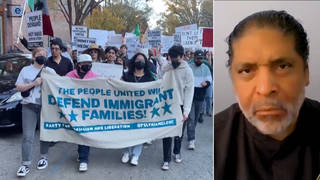
About 160 million voters cast ballots in this election, setting a new record, and President-elect Joe Biden’s lead in the popular vote has jumped to over 6 million. Much of the increased turnout was powered by people of color, while the total number of votes cast by white Americans barely increased from the last presidential election. “The main story is that in an election which saw historic turnout, people of color — and especially Latinos — had an unprecedented increase in voting,” says Democracy Now! co-host Juan González. “After decades of political experts talking about the growing Latino vote, this year it actually happened.”
Transcript
AMY GOODMAN: This is Democracy Now!, democracynow.org, The Quarantine Report. I’m Amy Goodman. We continue to look at this year’s historic election. We turn now to Democracy Now! co-host Juan González, professor at Rutgers University. He looks at how the corporate media missed the real story about Latinx voter turnout in the 2020 election and how Latino and Latina voters helped Joe Biden win the presidency.
JUAN GONZÁLEZ: Well, Amy, the cascade of stories continues, claiming a surprising turn by Latino voters toward Donald Trump. The New York Times this week, front page, quote, “How Democrats Missed Trump’s Appeal to Latino Voters.” Then, the L.A. Times, “Latino voters tired of being taken for granted by baffled Democrats.” CNN and others claiming there’s no such thing as a Latino bloc. And even The Intercept saying in one of their stories that “Nonwhite Voters Are Not Immune to Right-Wing Populism.”
Well, I said last week, and I’ll repeat it again, the key narrative of this election is not whether there was a small shift in the percentage of Latinx voters in some areas of the country turning toward Trump. The main story is that in an election which saw historic turnout, people of color — and especially Latinos — had an unprecedented increase in voting. And they, not white voters, represented the bulk of that increase. Virtually none of the reports have mentioned this, that for the first time in U.S. history Latinos’ turnout appears to have reached comparable levels to the rates for white and Black Americans. Twenty-point-six million Latinos went to the polls in this election. That’s 64% of the 32 million eligible Latinx voters, while in previous election cycles the turnout had been routinely below 50%. In raw numbers, 8 million more Latinos voted this year than in 2016. That’s a 63% increase over the last presidential elections.
Now, I’ve updated and tweaked the chart from last week, and it shows that the biggest increase in both percentages and actual votes from four years ago came from Latino voters. Their jump in number of ballots cast nearly equaled that among white — the increase among white and Black voters combined. The next biggest jump, in percentage term, came among African American voters, who increased by 20%, Asian Americans by 16%, while white voters increased by just under 6%.
Now, some of these numbers, I should note, are different from what I displayed last week, in part because there’s been some little-noticed changes to the Edison national exit poll in the past few days compared to what was released on Election Day by all the networks. For instance, the original version estimated that whites were 65% of the electorate, while the latest figures say that they were 67%. And the poll also increases turnout for African Americans and Asians. Well, the Edison poll has always been flawed, and numerous analyses have shown its past samples were skewed to oversampling Cuban Americans, undersampling both Black and Latino inner-city polling sites, and also undersampling voters whose primary language is not English, all of which means it tends to undercount Latino voters for Democrats.
But the basic contours of the sampling remains the same, and it’s inescapable. After decades of political experts talking about the growing Latino vote, this year it actually happened. Hispanic voters felt compelled like never before to go to the polls, because COVID-19 fell them more than other groups, because of the constant demonization of Latinos by the president, because of the barbaric family separation policies, or because of the threats to healthcare, even, for some conservative Latinos, because of their hopes of finally turning back Roe v. Wade. One thing is sure: Neither the Democratic nor Republican parties will underestimate or ignore Latino voters from now on. This should be cause for widespread celebration as a long-awaited democratization of the vote.
But what about those who claim that Trump made major, unexpected inroads among Latino voters nationwide, as reflected by 66-to-32% split of the Latino vote between Biden and Trump? Some say that Latinos could be deserting the Democratic Party. Those of us who’ve been around the block a few times have heard this narrative before. In reality, these results are in the general ballpark of previous presidential campaigns.
I want to put up, hopefully, a chart here of how Latinos split their vote over the last 30 years in presidential elections. The Republican share of voters has varied, from a low of 27%, when Mitt Romney ran against Barack Obama in 2012, to a high of 44%, that George Bush got in his second presidential run in 2004. Even John McCain, when he ran against Obama in 2008, got a similar percentage of the Latino vote as Trump did this year. And the high point, the Bush victory in 2004, we should note, is the last time a Republican candidate got a majority of the popular vote.
But the big difference now is that the Latinx vote is so much larger. When you get two-thirds of a vote, that has tripled in size in just a few years, you begin to achieve critical mass. No wonder Lindsey Graham is warning that if these elections aren’t changed somehow, Republicans will never win the White House again.
What about those places like the Rio Grande Valley of Texas and South Florida, where Trump made real inroads in largely Latino districts in the actual vote? What about those pundits who claim Latinos are so diverse and diffuse as a population that it is erroneous to consider them a single community? First, on South [Florida] and the Rio Grande Valley, yes, actual vote results show that Trump had significant increases in his support there. Florida is not surprising, given the influx of conservative refugees from Nicaragua and Venezuela in recent years, but the Rio Grande Valley is.
In Hidalgo County, along the border, which is 90% Latino, Trump went from 27% against Hillary Clinton to 40% against Joe Biden. In Maverick County, which is 95% Latino, he went from 20% against Clinton to 45% against Biden. Those are significant numbers. The Valley, however, has changed rapidly during the Trump era. Always a socially conservative rural area, it has seen enormous job growth in recent years as a result of the militarization of the border, which brought thousands of new jobs to the area for Border Patrol officers, for workers on private construction of the wall with Mexico, for immigration detention centers. In addition, the Valley has replaced the San Diego sector as the epicenter of undocumented migrant crossings and the failed immigration system of the United States. All of that, no doubt, helped turn its residents for Trump.
But in the big cities of Texas, where most Latinos live, there’s another story. San Antonio’s Bexar County, for example, 60% Latino, saw Biden’s margin of votes climb, from 54 to 58%, though we’ll need better figures on how much of that was in the Latino community. It seems clear, however, that Latino turnout in states like Nevada, Arizona and Pennsylvania helped Biden win those key battleground states.
And then there’s California and New York. The Latino share of the vote that went to Biden appears to be breathtaking in those states: 77% in California, 72% in New York. Now, some argue that those are reliable blue states anyway, so those Hispanic voters are not really critical. Really? Aren’t those enormous Latino margins year after year what has made those states reliably blue? And the same for New Jersey, Connecticut, Massachusetts and, lately, Colorado.
Then there are these nonsensical questions as to whether a Latino community actually exists. Let’s be clear: Latinx identity in the United States is a social construct, created both by the dominant society, that needed to define and categorize and other — other — and by the marginalized group itself, organically, from the ground, by disparate Latin American migrant groups who were forced to unite in order to survive in a hostile society and whose children gradually intermarried to create a new social construct: the Latino in America.
More than 20 years ago, I said in my book Harvest of Empire that Latinos had become — were becoming a new third force in American politics. They largely vote Democratic, but a significant portion is susceptible to Republican candidates if those political leaders address even a few of their concerns. Since then, Latin Americans from educated and middle-class backgrounds have migrated to this country in growing numbers, and a good portion have adopted typical American conservative views. Some of that community, though still a minority, have been drawn to right-wing populism, to national chauvinism, and even to racist views.
All of this fixation on Latinos, however, ignores the fundamental question of this election, which very few political observers I’ve seen have dared to tackle: Why the heck did 58% of white Americans vote for Donald Trump, including 55% of white women? With the United States consolidating itself as the world’s most powerful imperialist nation and the economic gap in the country widening, right-wing movements have only grown at home, and the defeat of Trump will not halt their growth. The key to building a progressive majority is to keep mobilizing more young Latinos to vote, burying the small percentage increases in support for right-wing candidates under an avalanche from people of color, organized labor and their allies.
AMY GOODMAN: Democracy Now!'s Juan González. To watch Juan's commentary in Spanish, visit democracynow.org/es.
When we come back, we’ll hear from Princeton University professor Eddie Glaude and antiracist activist Bree Newsome Bass. Stay with us.












Media Options